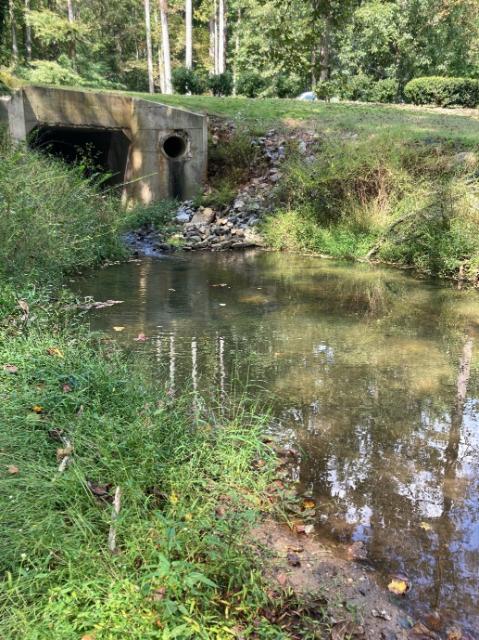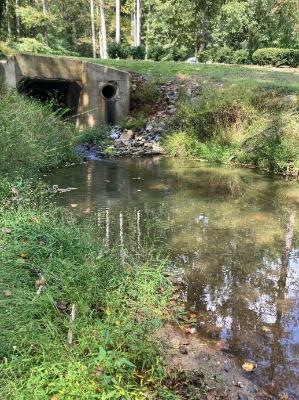Caitlan O’ Keeffe from Atlanta, Georgia, USA

This month features Caitlan O'Keeffe from Atlanta, Georgia (USA)
Following UNEP GEMS/Water alumni in their careers and helping maintain an alumni network beyond training at the UNEP GEMS/Water Capacity Development Centre (CDC) is highly important to us. To that end, and to give everyone a taste of what kind of projects that alumni of the CDC at UCC are working on, we are delighted to feature an update on the work of our MSc graduate Caitlan O'Keeffe. Caitlan is currently with Gwinnett County Department of Water Resources as a Water Quality Manager and is a graduate of the MSc in Freshwater Quality Monitoring and Assessment at UNEP GEMS/Water CDC (class of 2023!).
Caitlan’s water quality work in the South-Eastern United States:
Most people don’t wonder what happens to all the water that accumulates on the ground surface when it rains, but this is an important question in the South-Eastern United States! The State of Georgia has a humid subtropical climate with a total yearly rainfall average of greater than 60 inches (1,524 mm). With such high rainfall, it is no doubt that stormwater is a key influencer on surface water quality. This is especially true given the ongoing expansive development of the Atlanta metropolitan area and the subsequent increase in the percentage of impervious ground cover. Impervious ground cover is any sort of human-made surface that does not absorb water; this includes buildings, roads, parking lots, and so on. As you might expect, cities are full of imperious ground cover!
Increasing impervious ground cover increases stormwater quantity and velocity because the stormwater cannot penetrate the ground. This contributes to localized flooding and streambank erosion, as well as rapid degradation of surface water quality when accumulated pollutants on impervious surfaces are streamlined to surface waters during rain events. For this reason, municipally managed stormwater utilities (or MS4s) are required to hold and maintain compliance with an “MS4 permit” per federal law. My role at Gwinnett County Department of Water Resources is to manage the field activities required by the County’s MS4 permit, such as surveillance monitoring of impaired streams, targeted sampling to identify pollutant sources, proactive screening inspections to identify direct pollutant discharges to stormwater infrastructure, and water quality investigations and enforcement in response to reports from citizens and other agencies.

Figure 1. Example of typical stormwater infrastructure in Gwinnett County, showing a road culvert and outlet pipe with staining from an old pollutant discharge, located upstream from one of Caitlan’s sample sites.
At present, the most prevalent surface water quality concern in Gwinnett County is bacterial contamination. Most of the streams we currently monitor are impaired due to elevated Escherichia coli (E. coli) concentrations. E. coli sources within our jurisdiction are varied and can include sanitary sewer spills, industrial discharges, pet waste, refuse, wildlife (such as beavers), and more. The most common bacteria-related reports we investigate involve failing individual septic systems. These septic system failures cause untreated domestic wastewater to pool on the ground surface. Depending upon individual site design and severity of the failure, the septic effluent may even reach a stormwater structure that will eventually convey the septic waste to a nearby body of surface water. Rapid response and enforcement in these situations allow us to reduce the bacterial loading to surface waters from these issues. But, over 68,000 individual septic systems within Gwinnett County alone, I often wondered whether the quantity and density of septic systems exerts a measurable impact on water quality even when not actively failing. This is the subject I designed my dissertation study around.
 Figure 2. (a) Photos depicting beaver activity and (b) a beaver dam at one of the sampling sites for my dissertation project.
Figure 2. (a) Photos depicting beaver activity and (b) a beaver dam at one of the sampling sites for my dissertation project.
Caitlan’s Research with UNEP GEMS/Water CDC:
For my MSc project at the UNEP GEMS/Water CDC, 8 in-stream sample locations were selected to represent watersheds serviced primarily by individual septic systems as well as a sample location representing a primarily-sewered watershed (or control), for a total of nine sample locations. Each of these locations were sampled on ten separate occasions during baseflow conditions for Conductivity, Total Dissolved Nitrogen (TDN), Total Dissolved Phosphorus (TDP), and E. coli. Water quality results from the 8 septic-dominated watersheds were separated into two groups according to watershed characteristics associated with each sample location. These included septic system density (low density vs. high density), total septic systems (low total vs. high total), average septic system age (younger vs. older), and watershed size (small vs. large). The data was then subjected to statistical testing to identify significant differences between the two groups, as well as data from the sewered “control” site, and to elucidate the relationship between septic systems and instream water quality.

Figure 3. Map depicting study area within Gwinnett County, Georgia, USA, including major river basins, sample locations, and delineated drainage area boundaries for each sample location.
Perhaps the most significant finding was that baseflow conductivity values and TDN concentrations were both significantly greater in watersheds with high septic densities (> 200 individual systems/sq km) and with older septic systems on average (> 30 years old). E. coli concentrations were also significantly greater in the high-density septic watersheds. TPD concentrations were significantly greater within watersheds with greater total septic systems (> 329 total systems), regardless of density. These results support the theory that septic systems are a source of pollutant loading in the form of nutrients, bacteria, and dissolved ionic compounds to streams as baseflow contributions - even during dry conditions when the likelihood of an active failure impacting surface waters is unlikely. The caveat is that watershed size comparisons indicated that conductivity and TDN values were significantly lower in larger watersheds (> 1.5 sq km). In other words, the low-density septic watersheds were also the larger watersheds. As such, it is unclear to what extent watershed size versus watershed septic system characteristics influenced the trends in TDN and conductivity. Even so, the sewer-dominated “control” watershed represented the lowest TDN concentrations throughout the study and was mid-range in terms of watershed size, and TDP and E. coli values were not influenced by watershed size. These results can be used by water utilities to help justify capital projects for expanding sanitary sewer infrastructure and prioritizing septic-to-sewer transition projects in area with high septic system densities and older average septic system ages. The data may also assist environmental regulators and/or lawmakers with determining allowable lot sizes to minimize water quality impacts for future septic system installations.
How GEMS/Water CDC helped Caitlan:
The UNEP GEMS/Water programme has helped me to be more effective in my current job by equipping me with knowledge that allows me to make better-informed decisions based on current science, and providing me with tools that guide me along the process of developing a new monitoring programme and helping me to stay organized. I found it particularly useful that the MSc was all-encompassing and touched on all aspects of water quality. For example, I do not work in a laboratory but I often am tasked with developing monitoring programs and quality assurance plans for pollutants of concern that I do not have experience with performing the actual analysis on. While I do not need to know exactly how to perform the analysis, I do need to know how to direct my conversation with laboratory staff so that I can extract the information required for the programme. The QA/QC course mage a huge difference in the effectiveness of communication between me and the lab staff that perform our analysis, and helped me with understanding their QA/QC processes. The coursework also helped me to refine skills in report writing and assembly, as well as statistical analysis – all of which are skills I use daily. My manager even commented on one of the first monitoring data reports I assembled following the PGDip courses and mentioned that it was obvious I had learned a lot through the program. I’ve been recommending it to my staff and peers, too!
UNEP GEMS/Water Capacity Development Centre
UNEP GEMS/Ionad Forbartha Acmhainneachta Uisce
Contact us
Environmental Research Institute, Ellen Hutchins Building, University College Cork
